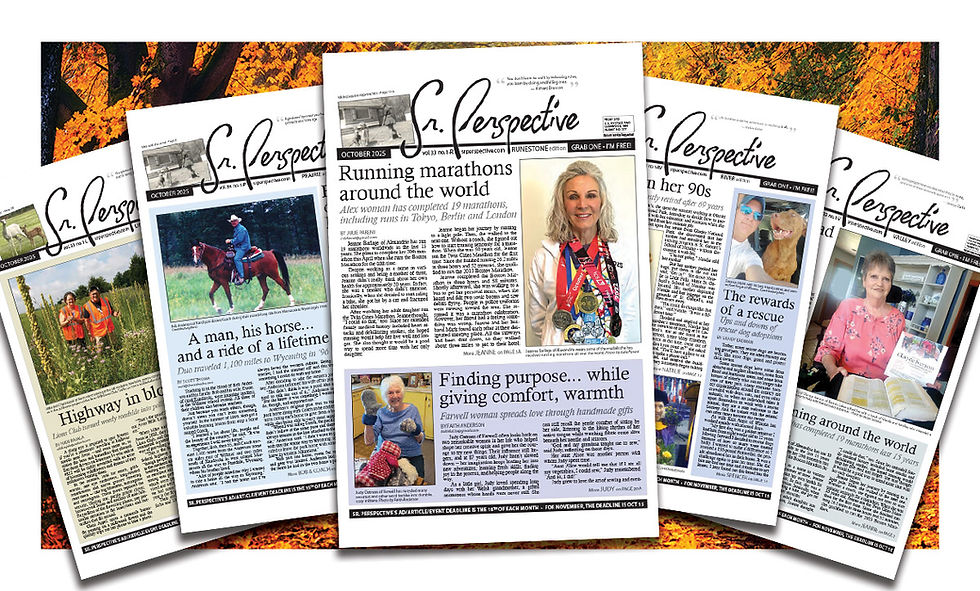A final salute
- Sr Perspective

- Aug 29, 2013
- 7 min read
Comfrey couple completes mission of memorializing crew killed near their town 50 years ago
For many of the past 50 years, Stan and Marianne Schotzko believed a memorial should have been constructed to remember the lives of four U.S. Air Force crew members who died when their B-47 bomber plane slammed into the ridge of a frozen meadow on Feb. 20, 1963, near the small prairie village of Comfrey.
Now, through the project design work and dedicated fundraising efforts of the Schotzko’s, the historical marker became reality when it was unveiled at a dedication ceremony held in Comfrey’s North Park on July 14.
In attendance was a large crowd, surviving family members of the lost airmen, friends, individuals involved in the search/recovery operation, military dignitaries, the Patriot Guards, a 21-gun salute and an impressive BT-13 Valiant flyover by the Minnesota Wing of the Commemorative Air Force.
The memorial includes four black granite markers and two sitting benches. The markers bear engraved artist images resembling each of the four airmen who were killed in the crash. On one bench is a U.S. Air Force insignia while on the other is the B-47 Stratojet that crew members were flying.
A memorial sign tells the story of the events that forever linked Comfrey and the plane together on a frigid, windy, fateful day in 1963.
B-47 crashes at 2:15 p.m. The story of the doomed “Iron Horse” mission began at Lincoln, Nebraska Air Force Base where the $1.8 million aircraft was based. The plane, a Strategic Air Command (SAC) bomber was part of the 343rd from the 98th Wing.
The plane was on a high-speed low-level simulated training mission (flying at about 500 feet) to the radar bomb scoring site located near Heron Lake, about 45 miles southwest of the crash site. It is believed parts of southern Minnesota’s landscape was chosen for this type of training because it were similar to targets and terrain they were Soviet Union or Europe.
The crew had finished the exercise and was climbing back to high altitude when one of the six engine mounts failed. The engine spun around the wing, putting the aircraft into an uncontrolled spiraling descent.
The bomber smashed onto farm land owned by Carl Renburg, about three miles northwest of Comfrey at about 2:15 p.m. It blasted a hole in the ground of 50 feet wide with a 25-foot deep crater.
The pilots, Capt. Donald L. Livingston, 31, and First Lt. Michael R. Rebmann, 23, were able to eject but did not survive the low-level parachute deployment, below-zero temperatures and 35 mph winds.
Capt. Livingston’s body was found the day of the crash about 1 ¼ miles north of Comfrey. Rebmann’s body was located 15 miles southeast of the crash site.
In the last radio call, one of the pilots said that navigator, 1st Lt. Thomas J. Hallgarth, 23, was out of his ejection seat replacing computer amplifiers for the next part of the navigation leg. His body was found a few hundred yards north of the crash site.
The instructor navigator, Lt. Col. Lamar Ledbetter, 41, did not have an ejection seat. Due to the resulting extreme gravity forces, he wasn’t able to escape the aircraft and was found three days later in the wreckage of the deep crater. Ledbetter joined the crew at the last moment as an observer of the mission.
Three of the men (Livingston, Hallgarth and Rebmann) were expectant fathers when they died. Hallgarth had just celebrated his 23rd birthday only two days earlier.
Three Civil Air Patrol airplanes along with 100 members on the ground and numerous civilians participated in the search and rescue operation around the crash site.
Following the crash, Air Force investigators descended on Comfrey along with engineers from Boeing Aircraft. Civil Air Patrol Major Bob Fedar, of Madelia, became the incident commander until he became ill with pneumonia and was hospitalized at the 12-bed Comfrey Hospital two days after the crash.
Col. Gerald Quilling became the new incident commander and reported the plane had shattered into thousands of small pieces. The largest remaining parts were two engines, one which was found a mile south of the scene.
Quilling, who attended the dedication ceremony, recalled that the people of Comfrey were most helpful in providing assistance to investigators and law enforcement officials who were there to protect crash evidence. “Comfrey was like Garrison Keillor’s ‘Lake Wobegone’ on the prairie during those five days after the crash…well done, Comfrey,” Quilling stated.
Schotzko’s remember the day For weeks after the crash Comfrey was a busy place with Air Force and law enforcement vehicles in town, many of them who stopped at cafe’s and Stan Schotzko’s Standard gas station.
Stan, who saw the plane go down from his station, had a contract with the Air Force to remain open 24 hours a day so that military vehicles and police who were patrolling the crash site could get gas whenever they needed it.
For the past 50 years, memories of the crash would occasionally enter Marianne’s mind. She was a junior at Comfrey High School and emotionally recalled the accident.
“There was a big boom, the school’s brick building shook and windows rattled,” she said. “We (students) ran to the windows to look north, and we saw a black mushroom-like cloud of smoke. She said this happened during the height of the Cold War, “so the thought went through our heads that this was something more than a plane crash at the moment it occurred.”
In the following days she remembers that Boy Scouts came to help with the recovery of small plane parts. “They would walk shoulder to shoulder and pick up little pieces to be turned in to the Air Force,” she said. Debris was found more than a mile from the crash site. She said an engine part wasn’t found until five years later when a farmer unearthed the piece with a plow in a field a mile southeast of the crash site. She added that sometimes little aluminum pieces of the crashed plane can still be found at the site today.
The Comfrey American Legion and Auxiliary Post 244 held a crash site service on the hillside spot the spring of ‘63. Hundreds came from the area to pay tribute and pray for the men who lost their lives in service of their country.
Marianne’s connection to the crash hit close to home, too, as she still lives on the farm where she grew up, about two miles from the site.
She said it’s because of the air crash that she met her future husband, Stan. A two-mile square perimeter around the crash scene was secured around the clock by members of the Minnesota State Patrol, Civil Air Patrol, plus county and local law enforcement.
“Because our farm was within the area affected by the crash, we got to know the checkpoint guys. One time I went along with them to town to get their trucks filled with gas and that’s where I met Stan at the station,” she stated.
Today, a U.S. flag flies at the south edge of the crater, which is about 200 yards south of a minimum maintenance road. A piece of the actual B-47 wing is mounted on a post at the head of the trail leading to the crater, which is still faintly visible.
Family connection Tammy Maher, the unborn daughter of Lt. Hallgarth, never met her father but began learning more about Comfrey as she started making inquiries to see the site where the crewmen perished.
In an online tribute she posted for her dad, Tammy wrote about the USAF wings, hats, pins and buttons she once found in an old family suitcase plus letters of condolences from President Kennedy and Arthur J. Lilla, Comfrey’s mayor in 1963.
Lilla sent a letter to the families saying… “We, the people of the village of Comfrey, and also the nearby farming area, feel that these men so guided their plane until the last moment to avoid crashing into the village, because of this effort, their bravery saved many lives.”
But Tammy wanted to know more. Now living in California, Maher made a visit to the crash site with her family two years ago to reflect on the life of her unknown father at his final resting place.
“When Tammy came out here for a visit and we took her out to the site where she found some small plane pieces to take home, that’s when the ball got rolling and we got serious about raising money to construct a memorial,” Marianne explained. The Brown County Veterans Council offered “seed money” of $1,000 to get started in hopes that other organizations or individuals would come forward with donations.
“After we got the ‘seed money’ the Comfrey Legion and Auxiliary took on the project to come up with the funds,” said Marianne.
It became Marianne’s tireless mission to “get it done” as Stan, who is also Comfrey’s Legion Commander, would say. She wrote 200 donation solicitation letters, articles were written for newspapers, presentations to various groups and organizations were made and food benefits were held. The Prairie Sampler Quilt Guild made a quilt to auction off for $300.
“I wrote and received a $2,000 grant from the Carl and Verna Schmidt Foundation in Rochester for historical projects and out of the blue we received a $5,000 donation from Dr. Vernon Ordiway,” Marianne said.
Ordiway was an Air Force flight surgeon who traveled to Comfrey to retrieve the remains of the crewmen. “He borrowed a horse from Vernon Pederson and rode around the crash site in below-zero weather for two or three days looking for the airmen’s remains,” she recalled.
To date, about $23,000 has been raised for the memorial, and donations continue to arrive. Friends and family of the deceased airmen have requested a scholarship fund be established for any excess funds to be presented in the names of the men to worthy graduating Comfrey High School seniors.
Forever grateful Marianne has been consumed with making the project a reality over the past two years. “It’s been a lot of work but I think it will help the families and the entire community have some sense of closure too.”
Her efforts haven’t gone unnoticed by the families of the lost airmen. Maher spoke at the dedication and said the families are “overcome with gratitude at the compassion and generosity of the good Samaritan people of Comfrey.
“From the first time I read that letter from your mayor as a small child I’ve felt connected to Comfrey,” she commented. She also feels a “sister” connection with the other airmen’s unborn daughter in Michele Rebmann and Pamela Ledbetter who was a high school senior when her dad died. They also were in attendance and spoke to the crowd.
“We appreciate the immeasurable efforts of Stan and Marianne. It took 50 years to get it done, but there is no time like the present,” Tammy said. “We lost beautiful men that terrible day, but I believe they’d want us to celebrate their memory with you today.”




Comments